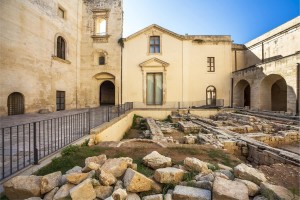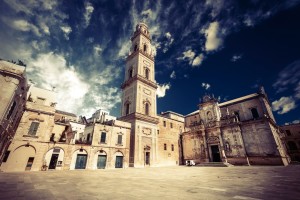Have you ever been to the “Florence of the south”? Lecce carries this soubriquet (“Florence of the rococo” is another popular one) with pride. The Apulian city is situated on the Salento peninsula and among the southernmost places in all of Italy. Wine and tobacco grow well in this particularly warm climate. Additionally, this still very wealthy city is an important military centre with its own airport and training ground as well as other facilities you’ll discover during a walking tour. And this walk is quite something as the city of arts Lecce will surprise you with architectural highlights ranging from Roman times to more recent additions.
From Troy to baroque art

©Bigstock.com/SchnepfPictures
You’re probably wondering how Lecce became this underrated gem. It actual origin is the stuff of myths and legends as the city supposedly already existed during the Trojan War and was allegedly founded by the Messapian king Malemnius in 1211 BC. Continuing this legendary origin story, Licitus Idomeneus occupied the city after the destruction of Troy and gave it both its name and the Greek culture. However, it remains unknown when Lecce was actually founded. The Romans conquered the area in the 3rd century BC and called it Lupiae. Emperor Hadrian later had the city moved three kilometres to the northeast. By then, it was known as Licea or Litium. Saint Oronzo advanced the Christianisation of the region during the 1st century AD. He has been venerated as the city’s patron saint since the plague epidemic of 1658.
Lecce remained part of the Eastern Roman Empire for over five centuries even after the Western Empire had fallen, notwithstanding a couple of intermittent conquests. It took the Norman’s conquest of Southern Italy to finally put an end to this affiliation. By uniting with Conversano, the seemingly dozy County of Lecce began its slow rise in 1360 leading to a magnificent heyday from 1550 to 1750. Charles V made the city his administrative centre of the Salento and fortified it. The iconic Lecce baroque style was born and spread across the entire cityscape in no time. The “Florence of the south” managed to retain this classic look to this very day.
The cathedral
Your wanderings of Lecce will lead you to a plethora of impressive monuments of classic architecture. The city cathedral, also known as Duomo di Lecce or Cattedrale dell’Assunzione della Virgine, is one of our personal favourites. Now a baroque masterpiece, this structure is way older than you might think at first glance. Built in 1144 and renovated in 1230, the cathedral was rebuilt in 1659 at the bishop’s disposition. The main portal is widely regarded as a baroque masterpiece. Statues, pillars and pilasters grace the main entrance.
A monumental building with a layout modelled after a Latin cross awaits you on the inside. Several paintings by Giuseppe da Brindisi depict Saint Oronzo and the salvation from the plague epidemic. The main altar is dedicated to the city’s patron saint. An incredible twelve small chapels, each with altars and elaborate artistic designs, can be found inside the cathedral. The slightly slanting 17th century belltower tops out at 72 metres. On clear days you can even see the Albanian mountain ranges beyond the Adriatic Sea.
Churches and basilicas in Leece

©Bigstock.com/Cordeschi
The imposing cathedral alone would be reason enough to visit Lecce, but that’s just the sacral start, if you will. Many additional churches and basilicas line your tour of the Apulian city of arts. Here are another three personal favourites you shouldn’t miss out on:
- Basilica di Santa Croce: Started in 1549 and only finished in 1695, this baroque church is the epitome of pomp. There’s so much to marvel at from the ostentatiously decorated façade with its pillars, grotesque figures and the rose window to the carved and gilded coffered ceiling.
- Santa Irene: Here’s another church that was built over a longer period of time, which you’ll see immediately. The upper and lower part of the façade are clear evidence of different stylistic influences. The numerous richly decorated altars with their paintings and busts, however, are the real highlight.
- Chiesa dei Santi Niccolò e Cataldo: This church certainly stands out among all the stunning baroque buildings as it managed to retain its original look. Despite extensive renovations of the façade in the 18th century and the addition of new statues Chiesa dei Santi Niccolò e Cataldo remains a Romanesque masterpiece.
Even more sights in Lecce
Enough churches for now? Time to check out a different side of Lecce’s architectural heritage. Or several sides, actually, as exciting journeys through time are next on the itinerary:
- Castle of Charles V: The fortification of Lecce during the rule of the Habsburg emperor was accompanied by the construction of an entire castle. A medieval structure was extensively reinforced and expanded in the 16th These days the castle is home to several cultural unions and events.
- Piazza Sant’Oronzo: Lecce’s population attributed the end of the plague epidemic to Saint Oronzo and made him the city’s patron saint. There’s an ancient pillar on the eponymous piazza. It was part of the twin pillars that marked the end of the Via Appia in Brindisi. A special statue of the saint was cast in Venice in 1739. It now rests atop the pillar.
- Amphitheatre: The Roman roots of the city were buried in oblivion and many houses and monuments had been built on top of them. Among these ancient Roman structures is an amphitheatre that used to seat more than 25,000 spectators. Partially excavated today, it serves as an event location. You can explore and marvel at other finds from days long gone in the archaeological museums Faggiano and Sigismondo Castromediano as well as in the archaeological park of Rudiae approx. three kilometres outside the city.
All that and much more accompanies your journey through Lecce. The southern city of arts in Apulia unearths unimaginable baroque treasures and is widely regarded as an Italian insiders’ tip with good reason. Let yourself be enchanted by art and architecture of days long gone and take a walk through over 2,000 years of palpable history. Enjoy your next holiday!